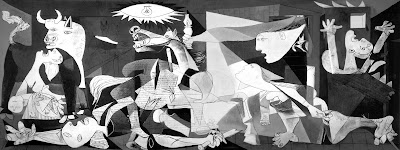Leading from
"The Treasures of Satan" trail
"The Treasures of Satan" trail
a) The Enigma of William Tell by Salvador Dali (1933)
b) Cadavre Exquis (Valentine Hugo, André Breton, Tristan Tzara, and Greta Knutson), “Landscape”, circa 1933
In comparison to Treasures of Satan
a) The sheet wrapped around Satan's arm transforms into the cushioning of the couch and the centre where his elbow becomes an eye
b) The naked figures in slumber are reduced to one, a sleeping woman at the top of the picture
c) The satan figure with his tail, in general are transformed into a black genie coming out of the shoe.
d) The fish whose tail can be seen on the lower left has been reflected and turned into a moustache, and the smaller fish beneath in a similar way has been turned into a pair of lips
e) The tendrils extending from the top of the upper part of the tentacles transform into the diagonal ribbing on the decanter
In comparison to Dix's Skat Players
a) The central figure from Dix's Skat Players with his leg stumps with sticks attached to them becomes transformed into the man bending forwards while someone leapfrogs over him.
b) The metal part of the central man's skull has transformed into the woman who appears to be sleeping
c) His large false eye has been given to the couch
d) The lightbulb has been turned into the stopper of the decanter
e) The right leg of the right chair and the shadow from the middle leg of the right stool transform into the high heel shoe
f) The black curling legs of the table transform into the moustache.
g) The arm rest of the right chair, and perhaps the curling table legs transform into the genie's tail
c) See "A surrealist family has the neighbors in to tea" - Cartoon from the New Yorker 2nd January 1937 by Carl Rose references E.L.Kirchner's "Studio of Painter"
d) Pablo Picasso's Guernica (1937)
Picasso's Guernica embraces details from Dix's Skat Players and Ernst's Celebes. The floating weed above in Celebes is transformed into the bull's tail, and various elements of Skat Players become transformed into the left side of Guernica.
 |
| Pablo Picasso's Guernica (1937) |
e) Yves Tanguy's Sans titre (1937)
The idea is that Yves took note of Celebes and so in this untitled composition would play around with some elements of it.
As far as I know, it's not written anywhere, I just pulled the idea out of a magic hat as far as any one could be concerned, as with much about these paintings and I didn't have a clue this image existed until five minutes before posting the image, but was drawn to it when searching for the possibility of such an image.
This drawing shows an undersea world with perhaps a fish. Perhaps Celebes' bull horns and/or elephant tusks have become the tuning fork like structure in the background. Perhaps the frill from Celebes' trunk has become the inverted frill here. Perhaps the tree like form from Celebes on the right has become part of the central structure of this picture.
Perhaps loose comparisons can be made to Guernica as well, such as the eye at the top is a reference to the light from Guernica.
f) Dali's "Debris of an automobile giving birth to a blind horse biting a telephone" (1938)
The idea is that Yves took note of Celebes and so in this untitled composition would play around with some elements of it.
As far as I know, it's not written anywhere, I just pulled the idea out of a magic hat as far as any one could be concerned, as with much about these paintings and I didn't have a clue this image existed until five minutes before posting the image, but was drawn to it when searching for the possibility of such an image.
This drawing shows an undersea world with perhaps a fish. Perhaps Celebes' bull horns and/or elephant tusks have become the tuning fork like structure in the background. Perhaps the frill from Celebes' trunk has become the inverted frill here. Perhaps the tree like form from Celebes on the right has become part of the central structure of this picture.
Perhaps loose comparisons can be made to Guernica as well, such as the eye at the top is a reference to the light from Guernica.
 |
| Sans titre (1937) Yves Tanguy |
f) Dali's "Debris of an automobile giving birth to a blind horse biting a telephone" (1938)
Dali
takes the horse near to the centre of Guernica and transforms it in to a
composition all about the horse merging with machinery, and perhaps
this also echoes the curiosity of Guernica that from one perspective
appears to be an elephant merged with a vacuum cleaner
 |
| Dali's "Debris of an automobile giving birth to a blind horse biting a telephone" (1938) |
g) André Masson's Dans la tour du sommeil, 1938,
Andre Masson paints his figure amidst the Guernica like destruction.
In
Delville's painting, there is an almost triangular shaded area to the
right that follows the slant of the pile of humans and perhaps he has
turned that into the harp, with the devils tentacle wings becoming the
upper part of the harp.
A
strip of ground covered with coins and a pale under sea plant leading
down diagonally to the bottom left of the painting becomes transformed
by Masson into the large human's leg.
Can we see signs of one in the other when we consider the curve of the left upper part of the harp that echoes the shape of the horse's rear?
 |
| André Masson's Dans la tour du sommeil, (1938) |





No comments:
Post a Comment